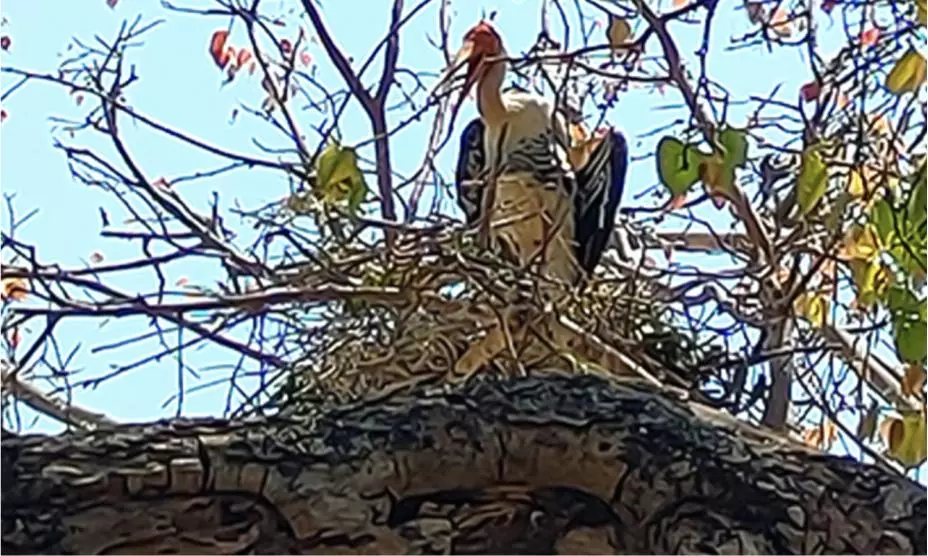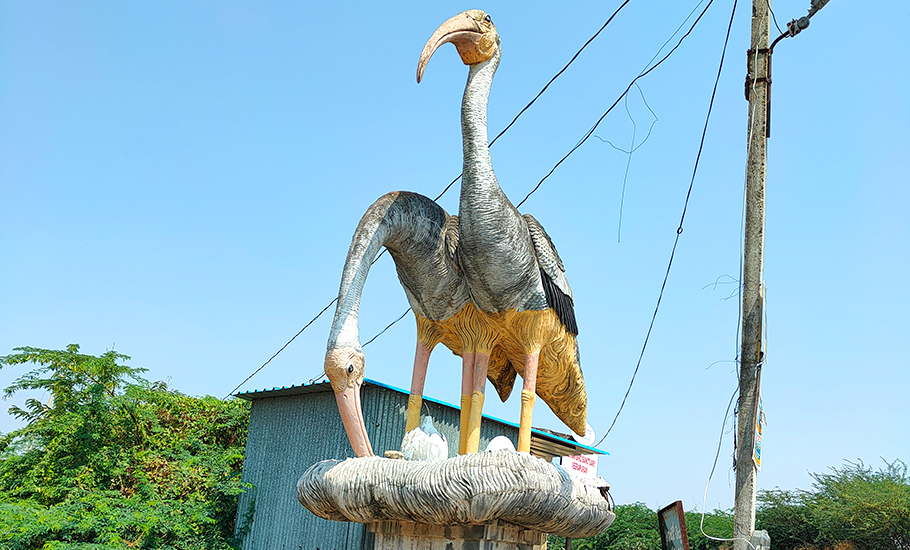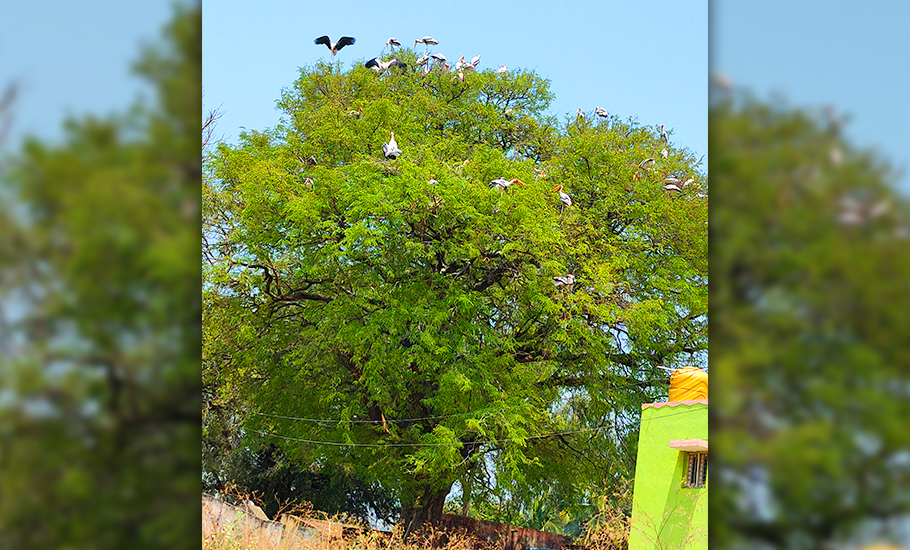
- Home
- News
- Analysis
- States
- Perspective
- Videos
- Education
- Entertainment
- Elections
- World Cup 2023
- Features
- Health
- Business
- Series
- Economy Series
- Earth Day
- Kashmir’s Frozen Turbulence
- India@75
- The legend of Ramjanmabhoomi
- Liberalisation@30
- How to tame a dragon
- Celebrating biodiversity
- Farm Matters
- 50 days of solitude
- Bringing Migrants Home
- Budget 2020
- Jharkhand Votes
- The Federal Investigates
- The Federal Impact
- Vanishing Sand
- Gandhi @ 150
- Andhra Today
- Field report
- Operation Gulmarg
- Pandemic @1 Mn in India
- The Federal Year-End
- The Zero Year
- Premium
- Science
- Brand studio
- Home
- NewsNews
- Analysis
- StatesStates
- PerspectivePerspective
- VideosVideos
- Entertainment
- ElectionsElections
- Sports
- Loading...
Sports - Features
- BusinessBusiness
- Premium
- Loading...
Premium

Why Painted Storks made an arid Andhra village their home – and never left

About 10 kilometres away from Veerapuram village, which falls in the Chilamathur Mandal in Satya Sai district of Andhra Pradesh, a statue of two Painted Storks (Mycteria Leucocephala) that stands partly hidden by a makeshift tin structure, is easy to miss apart for the asymmetry of its base and the endured neglect – seemingly running into years. The condition of the statue at the...
About 10 kilometres away from Veerapuram village, which falls in the Chilamathur Mandal in Satya Sai district of Andhra Pradesh, a statue of two Painted Storks (Mycteria Leucocephala) that stands partly hidden by a makeshift tin structure, is easy to miss apart for the asymmetry of its base and the endured neglect – seemingly running into years.
The condition of the statue at the Kodikonda checkpost on NH 44, turning towards Bengaluru from Anantapur, belies the attention the bird finds in Veerapuram village, where people have gone as far as giving up livelihood sources to ensure Painted Storks feel at home.
The man-bird relationship seen in Veerapuram, believed to be over 100 years old, is strange for other reasons too, including the fact that a bird found around wetlands is found in a village that falls in an otherwise arid geography.
Veerapuram is a tiny village near the Karnataka border inhabited by about 1,900 people with a literacy rate of 52 per cent, lower than the state average of 67.02 (2011 census). Literacy among women is still lower at 44 per cent. The village has a gram panchayat which incorporates many surrounding hamlets. The whole area is drought prone.

Surrounded by many hillocks, the village has a water tank. In fact, the area has many small irrigation tanks that store water which flows down the hill slopes when it rains. However, in any given decade droughts outnumber rains in the area. According to villagers, this precarious life dependent on rains made the bird-human coexistence possible in Veerapuram.
According to professor VV Bala Subramanyam from the Zoology Department of Sri Krishnadevaraya University, Anantapur, three factors seem to have attracted Painted Storks to the village. First, there are good foraging spaces in surrounding tanks. Two, risk of natural predators is low. And three, the area abounds in tamarind trees which provide the best roosting sites.
“The birds are believed to have made this village their roosting home 100 years ago. They might have found the village tank with a water-spread area of about 30 acres as an ideal roosting site while the villagers received these unknown guests as a cheerful omen for good harvest,” said Subramanyam, whose team studied the Painted Stork breeding colonies in Veerapuram as recently as 2019.
The popular belief that the large non-local birds couldn’t have arrived in the village unless it was destined by God, prompted the villagers to work for their conservation. Though the origin and destination of the birds remain to be properly investigated, the villagers believe that the birds come from Russia’s Siberia.
Irrespective of where they come from, the Painted Storks are a visual treat for bird lovers. One can observe the entire life cycle of the Storks starting from how they make and mend their nests. Villagers and visitors can see the birds carrying twigs from faraway places to build their nest. Watching how the birds preserve the eggs, incubate and hatch, feed the fledglings, and stand guard over the chicks against scorching heat and predators is an unforgettable spectacle.
Each tree in the village is a tiny colony of birds where 40 to 50 nests are built. While people vacate the village during day time to work in fields, the birds are busily engaged in their daily chores in the backdrop of the unending chirping of chicks. “It’s true. These birds are noisy. But we never find it irritating. It has become part of our village life,” said a villager.
“We were told by our parents that the birds first began building nests on the trees outside the village. Hunting of birds and stealing of eggs by outsiders, and accidental falling of hatchlings from nests were common. So, the villagers started coming to their rescue. The birds observed the villagers while they tried to rescue the fledglings by bringing them home for treatment and nurturing. Later, the birds started following the people whenever they carried the injured chicks to the village. Slowly this practice led to the birds shifting their nests to the trees in the village,” septuagenarian Bayappagari Aswarth Reddy told The Federal.
“In return for the trust they reposed on the village, villagers have banned all activities that would disturb their stay here,” Reddy said.
Another elderly man from the village narrated an interesting anecdote regarding the bond that developed between these birds and villagers.
“This happened during the British period. The tehsildar of Gudibanda in Karnataka once visited the village on horseback with his armed security guards. Upon visiting the village, he found the continuous chirping of the birds annoying. Disgusted, he snatched the gun from the security guard and fired at the birds. This act enraged the entire village. All villagers caught the official and tied him to a tree. He was not released until higher officials were involved and made him apologise to the village,” he said.
Lepakshi Lakshmipati Reddy, sarpanch of the village, narrated how the villagers made the area a safe haven for their guests.
“Though our irrigation is tank dependent, the village unanimously decided against drawing water for the fields. We have closed the tank sluice. Our land went back to the era of rain-fed farming. Similarly, we stopped harvesting tamarind as this activity is bound to disturb the nests. In another important move, we have stopped auctioning the tank in summer for fishing as this would rob the birds of the fish they relish. We have taken these steps at the cost of the village development. But they have ensured water and food to the birds,” the sarpanch said.
The villagers believe the Painted Storks are very clever birds as before starting their migration to Veerapuram, they send a flock of birds on a reconnaissance mission. These birds take back information on the availability of water and forage. If they notice a drought-like situation, they give Veerapuram a miss. Several studies corroborate the reconnaissance claim.

According to a study, in 2013, 24 birds were spotted in the first week of January. They wandered for a few days, and then left. In 1987 as well, about 30 to 35 birds were seen in the nearby Venkatapuram tank but did not nest. Many studies conducted between 1987 and 2013 at Veerapuran heronry revealed that the birds either did not nest or built limited nests.
But sarpanch Lakshmipati Reddy is a disappointed man. Despite the villagers going to great lengths to make the village a safe haven for the birds, the government has failed to compensate for the loss of revenue, he says.
The villagers fear the governmental apathy would lead to the destruction of the environment which has brought international recognition to the village. In 2005, half the village land was identified for acquisition for a Special Economic Zone (SEZ). The villagers challenged the decision in the High Court stating that the SEZ would destroy the hundred-year-old sanctuary of Painted Storks. “We owe a lot to these birds. We won the case. A disaster was averted for the village. The birds helped save the village. Do you need more in return from these innocent birds?” asked Puttaparti Narasimhareddy, the man who led the legal battle.

